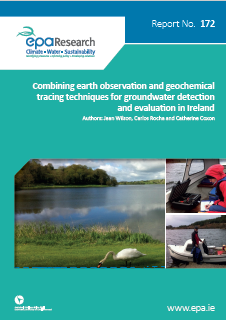Author: Jean Wilson, Carlos Rocha and Catherine Coxon
Summary: Precipitation that reaches the earth’s surface can infiltrate into the ground to become groundwater. Groundwater is subsurface water that fully saturates pores or cracks in soil and rocks. While an important source of freshwater globally, groundwater is also environmentally important as baseflow or low-water flow, which maintains river, stream and lake levels, as well as their associated ecosystems.

Nearly all surface water features interact with groundwater which means that pollution of surface water features can cause deterioration in groundwater quality and conversely, contamination of groundwater can degrade surface water systems. Groundwater-surface water interactions therefore may significantly impact water chemistry, water quality, biology and ecology and recent studies identify groundwater inputs as one of the main drivers of eutrophication in lakes and a precursor to algal blooms in coastal areas. Despite acknowledgement of its potential impact, groundwater discharge to surface-water features remains a poorly-understood process particularly when implementing water monitoring and management programmes in Ireland and elsewhere. This is because groundwater discharge is highly variable, both spatially and temporally,and identifying where and how much groundwater discharge is occurring is an extremely challenging task. In recognition of this knowledge gap and the implications for water managementpractices, the overall goal of CONNECT was to develop tools to facilitate a national assessment ofgroundwater discharge to lake and coastal waters in Ireland.
Groundwater discharge is a potentially significant source and pathway of freshwater and nutrientsto lakes and coastal areas with implications for the type and extent of monitoring requiredto fulfil national and international environmental policy objectives such as those defined aspart of the EPA’s Integrated Catchment Management (ICM) strategy to achieving second cycleWater Framework Directive targets. ICM necessitates a holistic and integrated approach to themanagement of land, biodiversity, water and community resources at the catchment scale whichrequires (in part) catchments to be viewed in three dimensions to facilitate a full and completeunder-standing of where water comes from and how it moves above, below and through thelandscape. This calls for the development of efficient tools to evaluate groundwater-surface waterinteractions in order to better understand and account for knowledge of the sources and pathwaysof groundwater discharge to lakes and coastal areas.
Research completed as part of the CONNECT project endeavoured to address knowledge gaps infield-based scientific information on the interaction between groundwater, lakes and coastal areas.GIS, remote sensing and geochemical tracing tools were developed and combined to detect andevaluate groundwater-surface water interactions. The outputs presented in this report can be usedpotentially to inform and guide any future studies seeking to localise and quantify groundwaterdischarge and associated nutrient loading to surface-water features.
https://www.epa.ie/media/epa-2020/publications/research/Research_172_image[1].png